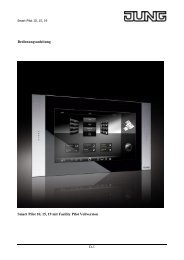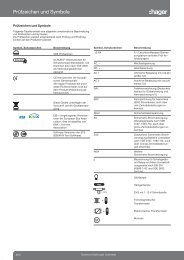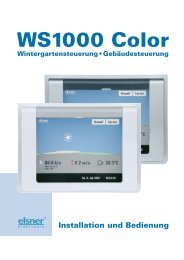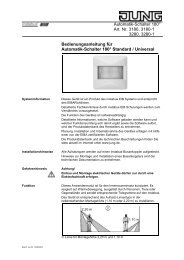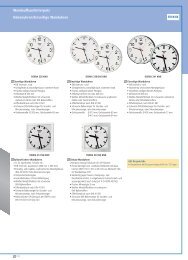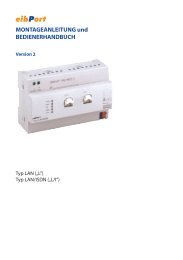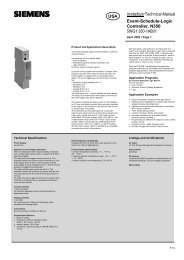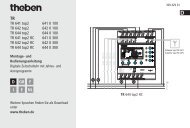You also want an ePaper? Increase the reach of your titles
YUMPU automatically turns print PDFs into web optimized ePapers that Google loves.
(8 bit values) for easier comprehension. This method of display is called dot notation. Here is an<br />
example of a possible IP address of the panel: 192.168.1.2.<br />
The panel also required a clear IP address for identification and communication in the local network.<br />
Subnet mask:<br />
The Internet address is subdivided into the Net ID and Host ID to distinguish between the individual<br />
networks. The Net ID addresses the network and the Host ID addresses the network subscribers<br />
(e.g. PC or panel). Telephone numbers are structured in a similar way. Here too, a distinction<br />
is made between the dialling code and the actual telephone number. The Net ID shows<br />
whether the recipient, to whom a network connection is to be setup, is in the same individual<br />
network as the sender or not. If this part of the IP address is the same for both the sender and<br />
the recipient, then both communication partners are located in the same network. If it does not<br />
match, then the recipient is located in a different network.<br />
Which part of the IP address belonging to the Net ID and which to the Host ID depends on the<br />
size of the individual network (subnet) and is primarily determined by the subnet mask.<br />
Just like the IP address, the subnet mask is also a 32 bit value, shown in dot notation. The panel<br />
also requires a subnet mask in the IP configuration to detect the relationship to the network<br />
topology.<br />
Standard gateway:<br />
If the subnet mask is viewed in binary, then the section of the Net ID is filled with ones and the<br />
section of the Host ID with zeroes. With each data packet to be sent, the sender compare their<br />
own IP address with that of the recipient. In so doing, the bits of the Host ID beyond the part of<br />
the subnet mask filled with zeroes is hidden. If the evaluated bits of the two IP address are<br />
identical, then the network subscriber to be contacted is in the same subnet. If just one of the<br />
evaluated bits is different, then the selected network subscriber is not located in the same subnet.<br />
In this case, the data packet must be handed over to a standard gateway to be switched into<br />
the target network - for example, the Internet. In many cases, the standard gateway is - and<br />
this occurs extremely often in private networks - a DSL router, which connects the local network<br />
with the Internet.<br />
The panel also requires the IP address of a standard gateway when communication beyond the<br />
borders of the local network is necessary.<br />
DNS-Server:<br />
There are millions of IP addresses on the Internet. Users would have difficulty handling the different<br />
addresses - even in smaller home networks - because the long numbers are either very<br />
difficult to remember or are completely unknown. This is where the DNS (Domain Name System)<br />
helps. Here, allocations of IP addresses and domain names are stored on DNS Servers,<br />
are constantly managed and polled as necessary. The DNS can be seen as the telephone directory<br />
of the Internet.<br />
The panel also allows the user or the installation engineer as an administrator to enter domain<br />
names rather than direct IP addresses at some points (e.g. for e-mail Servers or RSS sources).<br />
For this reason, the panel, just like a web browser, also needs the valid address of a DNS Server,<br />
in order to poll the names there and then resolve the IP address. Therefore, a DNS Server<br />
must also be entered in the IP configuration of the panel.<br />
i Valid IP addresses for DNS Servers are available from the network administrator or the responsible<br />
Internet service provider (ISP). In some cases, mini DNS Servers are already integrated<br />
in the Internet route of the network. However, this depends on the router used. In<br />
such cases, the address of the DNS Server is the same as the address of the standard<br />
gateway.<br />
DHCP:<br />
As described above, to communicate with other network subscribers, the panel needs their IP<br />
address, its own subnet mask and, if necessary, the IP address of an available gateway and of<br />
a DNS Server. These addresses can always be specified during panel commissioning and<br />
entered in the device configuration. For this, the network administrator must hand over the information<br />
to the operator or the installation engineer.<br />
In larger networks, this method soon causes a lot of configuration and management work. For<br />
this reason, amongst others, the use of DHCP (Dynamic Host <strong>Control</strong> Protocol) is advisable.<br />
Order-No. 7574 00 1X<br />
PC Client software<br />
Configuration data (IP, e-mail, RSS)<br />
Page 211 of 222




